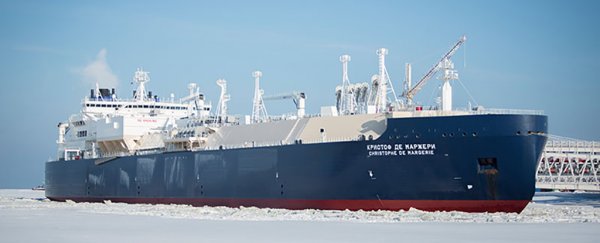In another sign of our warming world, a Russian tanker has completed an Arctic trip from Norway to South Korea in record time, becoming the first ship to cross the Northern Sea Route (NSR) without the aid of an icebreaker vessel travelling ahead.
Although that's partly due to shrinking ice coverage, the Christophe de Margerie vessel has also been specially built with this journey in mind – the ship comes with icebreakers already fitted.
However, there's no doubt that the thawing of the Arctic ice is making the shipping route more viable than ever. Fewer than 500 ships have made the journey since 1906, but Sovcomflot, which owns the tanker, expects journeys through this route to become routine in the future.
"Even if we stopped greenhouse emissions tomorrow, the acceleration in the loss of Arctic ice is unlikely to be reversed," oceanographer Simon Boxall, from the University of Southampton in the UK, told Patrick Barkham at The Guardian.
"We've been able to sail through the Northwest Passage for several years now but the Northern Passage, which goes past Russia, has opened up on and off since 2010. We're going to see this route being used more and more by 2020."
The tanker was carrying liquefied natural gas (LNG) and managed the trip in 19 days, knocking almost a third off the time it would take to go around Europe and through the Suez Canal.
At an average speed of 14 knots through the NSR, the ship had to contend with ice up to 1.2 metres (3.9 feet) thick. It's been built to handle ice up to 2.1 metres (6.9 feet) thick.
"It's very quick, particularly as there was no icebreaker escort which previously there had been in journeys," says Sovcomflot spokesperson Bill Spears. "It's very exciting that a ship can go along this route all year round."
Exciting for shipping companies, which get faster journeys and increased profits, but concerns have been raised about the environmental impact of the NSR becoming a regular route for ships in the next decade or so.
More ships in the area means more fuel being burned up, and experts are worried about how this could speed up the melting of the Arctic ice. Wildlife in the area could also be threatened by increased shipping traffic, while any major incidents – such as oil spills – would be more difficult to clean up in the partially ice-covered waters.
The Christophe de Margerie does have some green credentials: it can be partially powered by the LNG on board, which Sovcomflot says reduces sulphur oxide emissions by 90 percent and nitrous oxide emissions by 80 percent.
Even so, the eco-friendly features of tankers like this are unlikely to counterbalance the environmental impact of increased shipping traffic in the region.
"Common sense regulations, integrated ocean planning, and explicit protections are all needed before the resources of the region are targeted for exploitation or before it becomes a major shipping route," Whit Sheard, from the Circumpolar Conservation Union (CCU) group, told Reuters last year.
